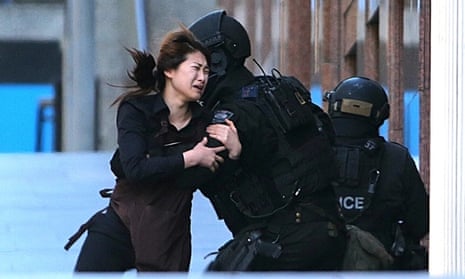It was Monday morning and Australia was winding down for Christmas.
There was a smattering of news around: some terrorism raids in north-west Sydney, the release of a business case for Victoria’s proposed East-West Link toll road and from Canberra, the release of treasurer Joe Hockey’s mid-year financial report.
Otherwise, Monday was a typical summer day – hazy, warm and soporific, made for skipping off work early, lazy lunches, Christmas shopping or drinks with friends.
Then, at 9.44am, it all changed. A man who had been a customer in the Lindt cafe in Martin Place, at the heart of the city’s business district, held a gun to the head of a worker. It was the beginning of a 16-hour siege, the aftershocks of which will be felt in Australia for some time to come.
9.40am, Monday: inside the Lindt cafe
The first anybody in the Lindt cafe knew something was wrong was when the manager of shop, Tori Johnson, had a gun pointed at him by customer Man Haron Monis.
Previously, Monis, 50, had been seated, talking with Johnson, the Monday-morning hubbub of the cafe all around them.
An 83-year-old former Wimbledon tennis player, John O’Brien, was in the cafe after his annual visit to the eye doctor. At another table were Louisa Hope, 50, and her mother Robyn, 70. Both live outside Sydney, but were enjoying an overnight stay in the city and had come to the cafe as a Christmas treat.
Also in the cafe were two Indian-born software engineers – Pushpendu Ghosh and Viswakanth Ankireddy, who were working on a project for nearby bank Westpac. Marcia Mikhael and Selina Win Pe, two more Westpac employees, were also customers.
Behind the counter were workers Joel Herat, Jarrod Hoffman, Harriette Denny, Fiona Ma, Elly Chen, Bae Jieun and supervisor Paolo Vassallo.
Scant attention was paid to Monis, who sat with a bag at his feet.
Then, almost without warning, Monis was standing.
He drew a gun – which, although not confirmed by police, has been reported as either a short barrelled or sawn-off shotgun – and bellowed at customers to stand with their hands up.
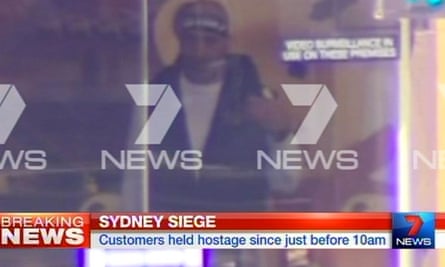
He screamed at them that he was a representative of Islamic State and that this was a terrorist attack.
He told them there were bombs in the building, and that they must do as he instructed. Monis locked the doors of the cafe and forced his hostages to stand still, their hands high in the air.
When a woman outside came to the automatic doors, banging on them to be let in, Monis waved the gun in her direction, a silent warning that no one was to come in – or out.
The woman alerted police, who quickly surrounded the building. Martin Place, busy for a year-end Monday morning, was hastily evacuated.
9.52am: first media reactions
News of an unusual situation, possibly an armed hold-up, was first broadcast to the wider world by a tweet from The Australian’s Chris Kenny at 9.52am. It said: “Scary situation Martin place – cops clearing area – woman says man may have shotgun.”
Guardian reporters checked the information with NSW police, who replied a “police operation was ongoing”.
Kenny added more detail, saying there were hostages with their arms against the window in the Lindt coffee shop. He had gone in for a takeaway coffee and narrowly missed being caught in the drama.
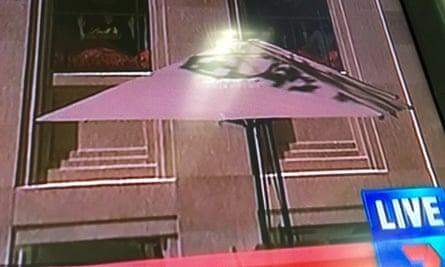
On the television, Channel 7 – whose headquarters are across the road from the cafe – were running a feed with commentary of the incident.
Morning Show hosts Larry Emdur and Kylie Gillies were on the air as armed police began to gather in the background of their shot.
Guardian reporter Oliver Milman jumped in a cab from nearby Surry Hills to the scene in the CBD. Almost immediately, his taxi was nearly hit by an unmarked police car, its balaclava-wearing occupants agitated to get to the scene, forcing its way through the traffic.
Martin Place station was being evacuated and a police cordon was placed around the cafe.
Milman saw a female hostage pressed against the third window down from the door. Black-clad police were huddled against the wall, a position they’d keep for the next 15 hours or so.
Office buildings and shops were evacuated and onlookers gathered. Channel 7’s studios were evacuated. Journalist Mieke Buchan, a guest on The Morning Show, had been in the makeup room when she was evacuated. “It looked like some sharp shooters went into the side door, and then police in protective gear basically came rushing in,” she said.
Many evacuated office workers thought it was a bomb scare. Westpac, which had staff members trapped in the cafe, closed all 12 of its CBD branches.
Jorge Bonora stood alone on the Macquarie Street corner of Martin Place, as close as he could to the cafe where his fiancee, Harriette Denny, was.
Police came and went, asking Bonora for information about the layout of the cafe as he had worked on the renovations a while back. Bonora had the phone number for the cafe’s architect but no one had come to get it from him yet. In the meantime he fielded dozens of texts and calls from worried family and friends.
Lindt cafe worker Nathan Grivas was also at the scene. He arrived for his shift, tried the doors – which were locked – and then caught sight of the gunman and his terrified colleagues through the glass.
“The doors were already shut, it all looked pretty dodgy. As soon as someone said gun, we got out. We called the cops and about a minute later all these guys on motorcycles arrived, so you realise it’s pretty serious,” he told the Guardian. “I was there for a bit because I had called the police and they wanted me to tell them the layout. I couldn’t be too much help because I only started on Friday. While I was there I saw a few of [my colleagues] up against the window with their hands up, I think one of them looked at me. He looked shocked. Lucky I didn’t start at nine.”
Meanwhile, the family of barrister Katrina Dawson were frantically trying to contact her via text. They had heard about the siege and were afraid she might be inside.
Dawson, who worked at nearby Eight Selbourne chambers, went to the cafe most days to buy hot chocolate.
On Monday she was accompanied by fellow barrister Julie Taylor. Stefan Balafoutis, another colleague, was also in the cafe.
Around 10am: Martin Place, Sydney
As crowds and police gathered, suddenly the captive Lindt workers appeared at the windows holding up a flag.
The black flag with white writing hung in the window was initially mistaken by many for an Isis flag.
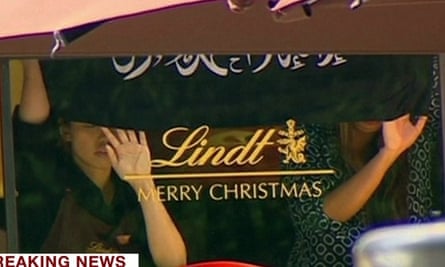
The pictures were broadcast instantaneously due to Channel 7’s live feed. This had turned from a siege at gunpoint to a possible terrorist attack. Rumours started to fly.
It turned out the flag was not an Isis flag. From the sliver of writing that could be made out in the early footage, it was identified correctly by some to be the Shahada – the Islamic creed “There is no god but God, Muhammad is the messenger of God” – rendered in calligraphic Arabic. The message appears on the flag of Saudi Arabia, the al-Qaida linked group Jabhat al-Nusra, and the radical group Hizb ut-Tahrir.
Meanwhile, Muslim community leaders were talking. It had been a busy morning. At around 9am, a number of them had received phone calls from the counter-terror unit of the New South Wales police. They were called to a briefing in Bankstown, to be held an hour later, about an arrest earlier that morning of a suspect in an unrelated terror financing case. The meeting ended early as police learned of the Martin Place incident.
Ahmed Kilani, publisher of the website Muslim Village, was one of about 10 community representatives in the meeting room who remained behind, following the siege on TV.
He recalled the moment the unmistakable shahada flag flashed on screen. “It was shock. Horror. Oh my goodness. This is our biggest nightmare coming to life,” he told the Guardian.
“And then it was about, well, who is this guy? So we’re ringing around asking, ‘Who is it?’, and people keep saying: ‘I don’t know’.”
11am: Martin Place, Sydney
About an hour into the siege, hostage Harriette Denny, a barista at the cafe, rang her fiance Jorge Bonora. She told him that she loved him but couldn’t speak and then she hung up.
Bonora thought she must have managed to call him from upstairs where staff lockers were kept, and that she sounded scared.
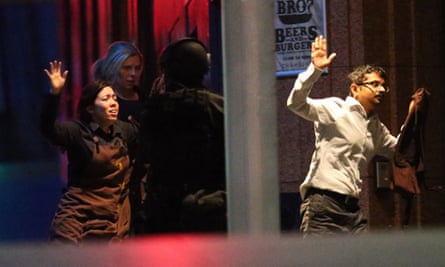
Police were called over to where Bonora was standing. They suggested Bonora text Denny back. She replied later, saying much the same thing: she loved him and couldn’t wait to see him. She would text at least once more but gave no information about the ordeal.
“She’s the sweetest person ever,” Bonora told the Guardian. “She took some of my old shoes and made me wash them and she gave them to a homeless guy. She just cares about everyone.”
First hours: rumours spread
A torrent of rumours swirled in those first heady hours. A bomb had been defused at Sydney Opera House. Two more had been planted in the city. Two more still were being toted by the gunman inside the cafe.
There was speculation that a police chase through city streets was a second gunman. It was unrelated to the siege, police said.
Sydney radio host Ray Hadley reported that there were terror raids in Lakemba, a suburb with a large Muslim population.
Citing Hadley, the rumours spread across social media. But the truth turned out to be more prosaic – it was a pre-arranged police tour of a mosque. There were no raids.
And how many hostages were inside the cafe? It seemed no one knew. Estimates ranged from eight to 50, with dozens of figures in between.
In the panic, buildings were evacuated or closed, even some thousands of kilometres from the siege, including the Victorian parliament building and Lindt shops in other cities.
Screenshots from flight tracking websites flooded Twitter, showing masses of aircraft allegedly diverting from Sydney airport, claiming airspace above the city had been shut down. Mobile phone reception in the CBD would soon follow, some said on Twitter. These rumours worked their way into online mainstream media coverage and in those feverish early hours were reported in some places as fact.
Lunchtime: phone calls to the media
Throughout the day, Monis forced his hostages to call media outlets around the country and act as his spokesperson.
They called newsrooms at radio station 2GB, TV stations Nine, Seven and Ten as well as News Corp Australia and the ABC, relaying Monis’s demands. Those on the receiving end of the calls reported hearing the gunman barking orders in the background. But all media had been requested by police not to go to air.
Channel Ten reported his demands, as well as the claim there were bombs in the city. Journalist Hugh Rimington said afterwards that police had not specifically asked them not to air the messages.
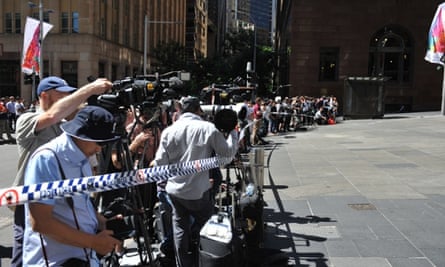
2GB’s radio presenter Ray Hadley took the call off air, but let listeners know that the hostages had been in touch. 2GB said the phone call had been verified by NSW police commissioner Andrew Scipione, but asked about it at a press conference shortly afterwards Scipione would not confirm or deny it.
So what did Monis want? In exchange for an on-air live broadcast phone call with Tony Abbott, Monis was prepared to release five hostages.
In exchange for a public declaration from the government that his was an act of terror committed on behalf of Islamic State, he was prepared to release two more.
And for a black Isis flag he was prepared to release a final prisoner.
As the standoff dragged into the afternoon, Monis began to realise his message was not being heard.
Afternoon: inside the Lindt cafe
Monis was spreading terror and fear amongst his captives. Some screamed, while others burst into tears, sobbing uncontrollably. At least one hostage began to vomit in fear.
Monis became furious once he realised his messages were not being broadcast by media outlets.
“We’re not getting out of here,” one hostage said to another, “none of us are. We are going to die here.”
When a hostage’s phone rang and was answered, Monis screamed: “Drop that phone!”
Monis was the only person holding a weapon in the cafe. But he realised he could not, alone, keep control of so many hostages.
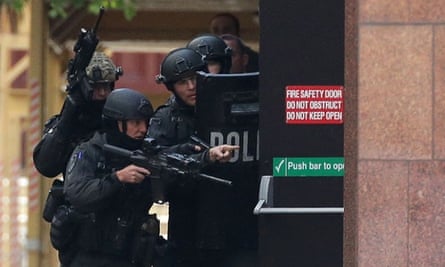
“The gunman was surrounding himself with the staff from Lindt,” the Guardian was told by a hostage, “forcing them to stand near him, he was using them to control the social media, to get his message out. He was directing them on what to do, who to call, what to say.
“The other people, the older people, he pushed to the other side of the shop, he kept them there.”
1.30pm: Lakemba, Sydney
The gunman was refusing to engage with police negotiators. Hours passed without a clue about his identity. According to sources, at around 1.30pm officers invited senior Muslim leaders to a south-west Sydney police station and distributed photographs of the assailant. Did anyone recognise him?
“It could be Sheikh Haron,” one finally said, referring to a notorious self-styled peace activist.
Police scrambled to compare the photographs to police videos from the previous day, when Haron, or Man Haron Monis, had checked in with police in line with his bail conditions. The pictures matched.
Superintendent John Reilly, commander of the NSW counter-terrorism special operations group, told the Guardian that around the same time, across the city, a number of Muslim and police sources were also coming to the conclusion that Monis was the gunman.
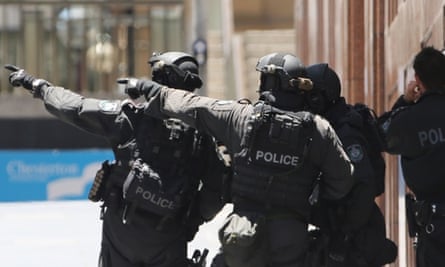
Nearby, Ahmed Kilani’s phone was ringing. “This is going to sound really weird and strange,” the officer on the other end of the line said. “But I want you to try to get me an Isis flag.”
Kilani said he was struck by the request, but not offended. “Our relationship is so good with these guys, we discuss everything openly. So there was no embarrassment, nothing.”
Still, he had never actually seen an Isis flag in Australia. “Maybe we could make one up for you?” he asked.
Reilly says the request for the Isis flag came “fairly early” in the siege.
“Just to have one on tap, we contacted community leaders. So they’re ringing around trying to find one for us,” he said. “And eventually we were able to get one.”
Reilly said the flag was provided in “good faith” that there would be no repercussions. “We haven’t gone looking for the source of it. If we’re asking for something, we’re not going to persecute [the owner].”
3pm: Elizabeth Street, Sydney
In the afternoon, a coordinated area for families of the hostages was set up near St James’s station.
But even inside the dedicated support and information centre, relatives received news the same way the rest of the country did, watching or reading the news. Some would wander out to the street for a cigarette or fresh air.
The family of barrister Katrina Dawson decided not to say anything to her three young children, hoping that she would emerge from the ordeal unscathed.
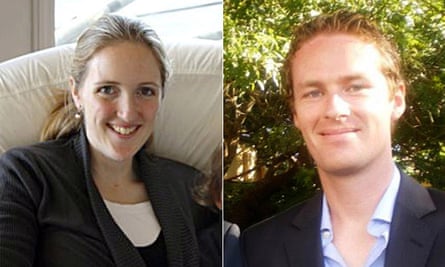
For the first hour Bruce Herat, father of hostage Joel, was kept at police barricades without information.
“About two and a half hours later we were told that a special room was being set up [for the families] in the old criminal courthouse,” Herat told Fairfax Media.
“We were given very neutral information first at around 2pm on Monday. Looking back it was frustrating … but they wanted to be able to deliver information efficiently, when all the families were gathered round, rather than having to repeat it a dozen times when each of the families arrived, so I can see the logic of it.”
3.37pm: the first escape
In the cafe, the tension was horrific.
“There was no reasoning with him, he was so angry,” one hostage told the Guardian. “He knew his message was not getting out, and he was getting angrier and angrier.”
There were moments, however, of calm and of conciliation. Hostages were allowed to take drinks of water, and one woman who had medication was given permission to take it.
When his captives asked to go to the toilet, Monis deputised a member of the cafe staff – themselves hostages – to escort them, and bring them back to the shop.
But as the afternoon dragged on, Monis, grew more erratic and unpredictable. Hostages began to plead with their captor. Some begged to be released, pleading to see their families. Monis refused.
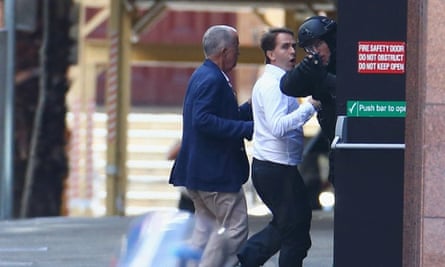
Hostages Stefan Balafoutis and John O’Brien asked to go to the toilet, and, being escorted past the glass doors, asked the staff member pressed into being their sentry whether the green button at the base of the door would open it.
The staff member did not know. “I’ve only worked here for about a week.”
It was 3.37pm, and the siege had run nearly six hours. The men decided to take their chances.
As Monis was focused on speaking to the people nearest to him, they ran for the front door, and pushed at the button.
The doors slid open, and they sprinted to safety.
Then a third, Lindt supervisor Paolo Vassallo, escaped through a fire door nearby.
4.57pm: the second escape
The police were armed and in position – as they had been since the siege begun around seven hours earlier.
Abruptly, two Lindt employees, Elly Chen and Bae Jieun 20, ran out of the cafe within seconds of each other. Bae Jieun was the first to escape. Distress etched on her face, she ran into the arms of a police officer. Elly followed seconds later.
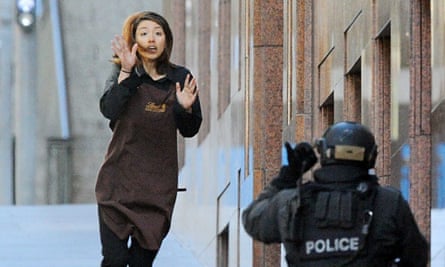
Photographers were there to catch images which went around the globe – they went on to become the faces of the Sydney siege.
6.16pm: Martin Place, Sydney
The crowd had grown to about 400 but spectators had become more sedate. Nadia El-Mouelhy, who watched from the gutter, said she felt compelled to come to Martin Place to see if she could help. “I feel so sorry for the people inside. This isn’t Islam, it’s stupid.”
Channel 7 journalist Chris Reason had been allowed back into the evacuated Martin Place newsroom. He and a cameraman were positioned next a police sniper, looking directly into the cafe. He said the hostages were being rotated near the window and food had been delivered to them.
Meanwhile on social media the hashtag #illridewithyou was gaining momentum both in Australia and overseas. Earlier in the day Michael James had tweeted a screenshot from the Facebook profile of a woman named Rachel Jacobs, who said she had seen a Muslim woman in Brisbane take off her hijab after news of the siege broke. At 4.28pm, Twitter user Tessa Kum built on Jacobs’s actions, offering to travel with any Muslims who felt unsafe wearing religious attire.” A minute later, she tweeted: “Maybe start a hashtag? What’s in #illridewithyou?”
By 6pm it had been mentioned 90,000 times and was trending worldwide, with countless news outlets mentioning it as a bright spark of hope in a tragic day.
Around 8pm: inside the cafe
When it got dark Monis started handing out food to hostages but realised the cafe lights made him visible to those watching outside. He asked a woman to turn them off. Mike Bowers, a Guardian photographer stationed nearby, caught an image of a cafe worker in an apron turning off the light. All went dark.
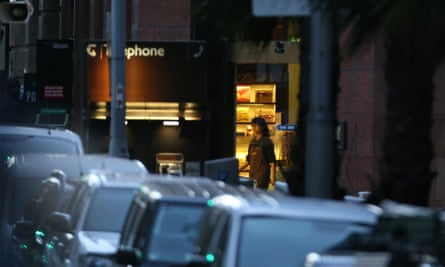
“Later on a dim light came on and you could see silhouettes,” Bowers said.
It started getting cold, the winds racing through the empty canyons of Martin Place. As time passed the crowds dispersed, but the police remained in position.
Soon after midnight: videos uploaded
Just after midnight, the first video from inside the Lindt cafe was uploaded to the internet. The clip, which looked as though it had been shot from a phone, featured a woman in front of the same Islamic flag that had been displayed from the window hours earlier.
Soon four videos had been uploaded. The speakers, all women, warned of bombs in the city that would be “ignited” if the hostage taker’s demands were not met.
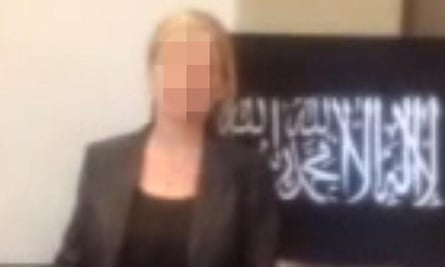
“We do not understand why these demands haven’t been met yet, they are not unreasonable. He is only asking for a flag and a phone call,” one hostage said. She called the man “our brother”.
Hostage Joel Herat was forced to upload the videos through his Facebook and YouTube account.
Herat’s father told Fairfax: “I felt somewhat cold when I saw those, thinking if [the gunman] is going to that resort, then obviously he is starting to target people as emotional conduits to get what he wanted. My concern then was how far would he go.”
Early morning Tuesday: inside the cafe
Around 2am Monis became agitated and started moving hostages around in two groups. As Monis moved one group, the other group of seven made a dash for the door.
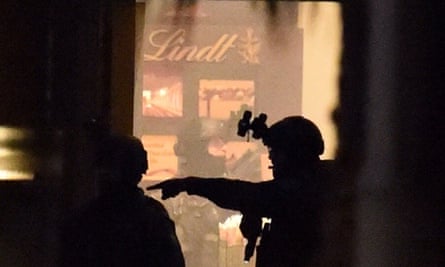
Bruce Herat said his son’s group of hostages decided to kick down an internal door and escape.
“From what Joel told me initially, towards 2am Monis started to bring groups of people together in close proximity from where they had been dispersed throughout [the cafe]”, Herat told Fairfax Media.
“And at that point in time, Joel and five others came to the conclusion that they were not going to survive until the morning if they did not do something. So I think him and Jarrod [Hoffman, another hostage] basically came to the conclusion that they would bust down the door. And I know that Joel made sure that Harriette [Denny] ... got behind him and he said, ‘You’re coming with me’, and basically made sure that all that group were ready to go when Joel and Jarrod broke down the door.”
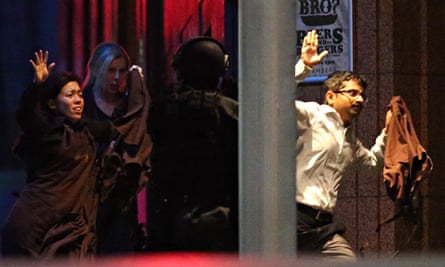
The group was seen fleeing the building just minutes before heavily armed police stormed the cafe with flash grenades and live ammunition.
The gunfight was over in about 30 seconds, and from the cafe police and emergency officers emerged carrying injured hostages. Three were on stretchers and a fourth hostage was carried in the arms of two officers.
Louisa Hope, who had reportedly been used as a human shield by Monis when police entered, had been shot in the foot. Her mother was shot in her shoulder. Another woman was shot in the leg, while a police officer received a minor facial injury from a gun pellet.
Ambulance officers worked frantically, administering CPR on the sidewalk to barrister Katrina Dawson, a mother of three who had been shot. She was pronounced dead at hospital.
Tori Johnson, the cafe manager, was also killed during the siege, reportedly shot in the head by Monis.
Monis was the third person killed during the siege.
